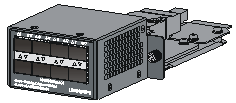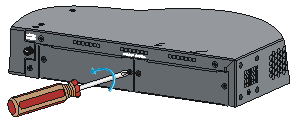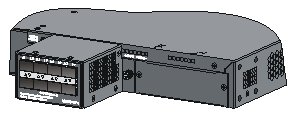| Title | Size | Downloads |
|---|---|---|
| H3C LSP5GP8P0 Interface Card User Manual-5PW101-book.pdf | 322.78 KB |
- Table of Contents
- Related Documents
Introduction to LSP5GP8P0
Overview
Each LSP5GP8P0 interface card provides eight 100/1000 Base-X SFP ports.
Figure 1 Appearance of the LSP5GP8P0 interface card

Figure 2 Front panel of the LSP5GP8P0 interface card

|
|
NOTE: The LSP5GP8P0 interface card is applicable to multiple models of H3C switches, and the switch models that it applies to may update with time. For the latest information, contact H3C technical support or marketing staff. |
Description of SFP Ports
Each LSP5GP8P0 provides eight 100/1000Base-X SFP ports. You can insert an SFP transceiver module into the port to connect it to another SFP port through an optical fiber. Select GE SFP transceiver modules (as shown in Table 1) or FE SFP transceiver modules (as shown in Table 2) as needed.
Table 1 GE SFP transceiver modules supported by LSP5GP8P0
|
Transceiver module |
Central wavelength |
Connector |
Interface cable |
Max transmission distance |
|
SFP-GE-SX-MM850-A |
850 nm |
LC |
50/125 µm multimode optical fiber |
550 m (1804.5 ft) |
|
62.5/125 µm multimode optical fiber |
275 m (902.2 ft) |
|||
|
SFP-GE-LX-SM1310-A |
1310 nm |
LC |
9/125 µm single mode optical fiber |
10 km (6.2 miles) |
|
SFP-GE-LH40-SM1310 |
40 km (24.9 miles) |
|||
|
SFP-GE-LH40-SM1550 |
1550 nm |
LC |
40 km (24.9 miles) |
|
|
SFP-GE-LH70-SM1550 |
70 km (43.5 miles) |
|||
|
SFP-GE-LH100-SM1550 |
1550 nm |
LC |
100 km (62.14 miles) |
|
|
SFP-GE-LX-SM1310-BIDI |
TX: 1310 RX: 1490 |
LC |
9/125 µm single mode optical fiber |
10 km (6.2 miles) |
|
SFP-GE-LX-SM1490-BIDI |
TX: 1490 RX: 1310 |
|||
|
SFP-GE-T |
— |
RJ-45 |
Twisted pair cable |
100 m (328.08 ft) |
Table 2 FE SFP transceiver modules supported by LSP5GP8P0
|
Transceiver module |
Central wavelength |
Connector |
Interface cable |
Max transmission distance |
|
SFP-FE-SX-MM1310-A |
1310 nm |
LC |
62.5/125 µm multimode optical fiber |
2 km (about 1.2 miles) |
|
SFP-FE-LX-SM1310-A |
1310 nm |
LC |
9/125 µm single mode optical fiber |
15 km (about 9.3 miles) |
|
SFP-FE-LH40-SM1310 |
40 km (24.9 miles) |
|||
|
SFP-FE-LH80-SM1550 |
1550nm |
LC |
80 km (about 49.7 miles) |
|
|
SFP-FE-LX-SM1310-BIDI |
TX: 1310 RX: 1550 |
LC |
9/125 µm single mode optical fiber |
15 km (about 9.3 miles) |
|
SFP-FE-LX-SM1550-BIDI |
TX: 1550 RX: 1310 |
|
|
NOTE: · H3C recommends you to use SFP transceiver modules of H3C on the LSP5GP8P0. · BIDI modules must be used in pair. For example, if an SFP-GE-LX-SM1310-BIDI is used at one end, another SFP-GE-LX-SM1490-BIDI must also be used at the other end. · The types of SFP transceiver modules may update with time. For information about them, contact H3C technical support or marketing staff. · For the models and specifications of each kind of SFP transceiver modules, see H3C Low End Series Ethernet Switches Pluggable Modules Manual. |
Description of LEDs
The LSP5GP8P0 interface card provides a port status LED for each port on the panel. It indicates the working status of an SFP port together with the port mode LED on the switch.
|
Port mode LED on the switch |
Port status LED on the interface card |
Description |
|
Steady green (rate mode) |
Steady green |
The port operates at a rate of 1000 Mbps; the LED is fast flashing when data is being sent and/or received on the port. |
|
Steady yellow |
The port operates at a rate of 100 Mbps; the LED is fast flashing when data is being sent and/or received on the port. |
|
|
Flashing yellow (3 Hz) |
POST failed on the port. |
|
|
Off |
The port is not up. |
|
|
Steady yellow (duplex mode) |
Steady green |
The port operates in full-duplex mode; the LED is fast flashing when data is being sent and/or received on the port. |
|
Flashing yellow (3 Hz) |
POST failed on the port. |
|
|
Off |
The port is not up. |
|
|
NOTE: Port status LED of the LSP5GP8P0 interface card is affected by the port mode switching button on your switch. For more information about the port mode switching button, see the installation guide of the switch. |
The following tools are needed for installation and removal:
· Phillips screwdriver
· ESD-preventive wrist strap
|
|
NOTE: The installation tools are not shipped with H3C’s devices. You need to prepare them by yourself. |
Installing the LSP5GP8P0 Interface Card
Installing the Interface Card to the Switch
|
|
NOTE: The procedure of installing the LSP5GP8P0 interface card to different models of H3C switches is similar. This manual takes the S5500-34C-HI switch as an example. |
1. Wear an ESD-preventive wrist strap and make sure that the wrist strap has a good skin contact and is properly grounded.
2. Loosen the mounting screws of the filler panel on the interface card slot of the switch, with a Phillips screwdriver and remove the filler panel, as shown in Figure 3.
Figure 3 Install an interface card (I)

3. Gently push the interface card in along the slot guide rail until the interface card is in close contact with the switch, as shown in callout 1 of Figure 4.
4. Tighten the captive screws with a Phillips screwdriver to fix the interface card, as shown in callout 2 of Figure 4.
Figure 4 Install an interface card (II)

|
|
NOTE: · Keep the removed filler panel properly for future use. · When tightening the fastening screws at both sides of the interface card with a screwdriver or an electric screwdriver, make sure that the torque is not bigger than 0.4 N-m. · When an LSP5GP8P0 interface card is installed on the switch, the depth of the switch is increased by 69.75 mm (2.75 in), as shown in the Figure 5. In addition, you must reserve some space for transceiver modules and fibers. Select a rack with a depth of 800 mm (31.50 in) or 1000 mm (39.37 in). |
Figure 5 After an LSP5GP8P0 is installed

Removing the Interface Card
1. Wear an ESD-preventive wrist strap and make sure that the wrist strap has a good skin contact and is properly grounded.
2. Use a Phillips screwdriver to loosen the captive screws at both sides of the interface card until all spring pressure is released.
3. Pull the interface card towards you along the guide rails, until it completely comes out of the switch chassis.
|
|
CAUTION: When installing or removing an interface card, note the following guidelines: · Do not touch the surface-mounted components directly with your hands. · Do not use excessive force in the operation. · After removing an interface card, if no new interface card is to be installed, install the filler panel as soon as possible to prevent dust and ensure the normal ventilation in the switch. |
Installing an SFP Transceiver Module
To avoid component damage resulting from improper installation, carefully read H3C Pluggable SFP/SFP+/XFP Transceiver Modules Installation Guide from the H3C's website before installing the SFP transceiver modules.
Verifying the Installation
When the switch runs properly, check whether the interface card is operating properly according to the status of the Port LED on the LSP5GP8P0 interface card.
Hangzhou H3C Technologies Co., Ltd. provides customers with comprehensive technical support and service. If you purchase the products from the sales agent of Hangzhou H3C Technologies Co., Ltd., please contact our sales agent or technical personnel.
Address: 310 Liuhe Road, Zhijiang Science Park,
Hangzhou, Zhejiang Province, P. R. China
Postal Code: 310053
Website: http://www.h3c.com
E-mail: service@h3c.com
BOM: 3101A0B4

